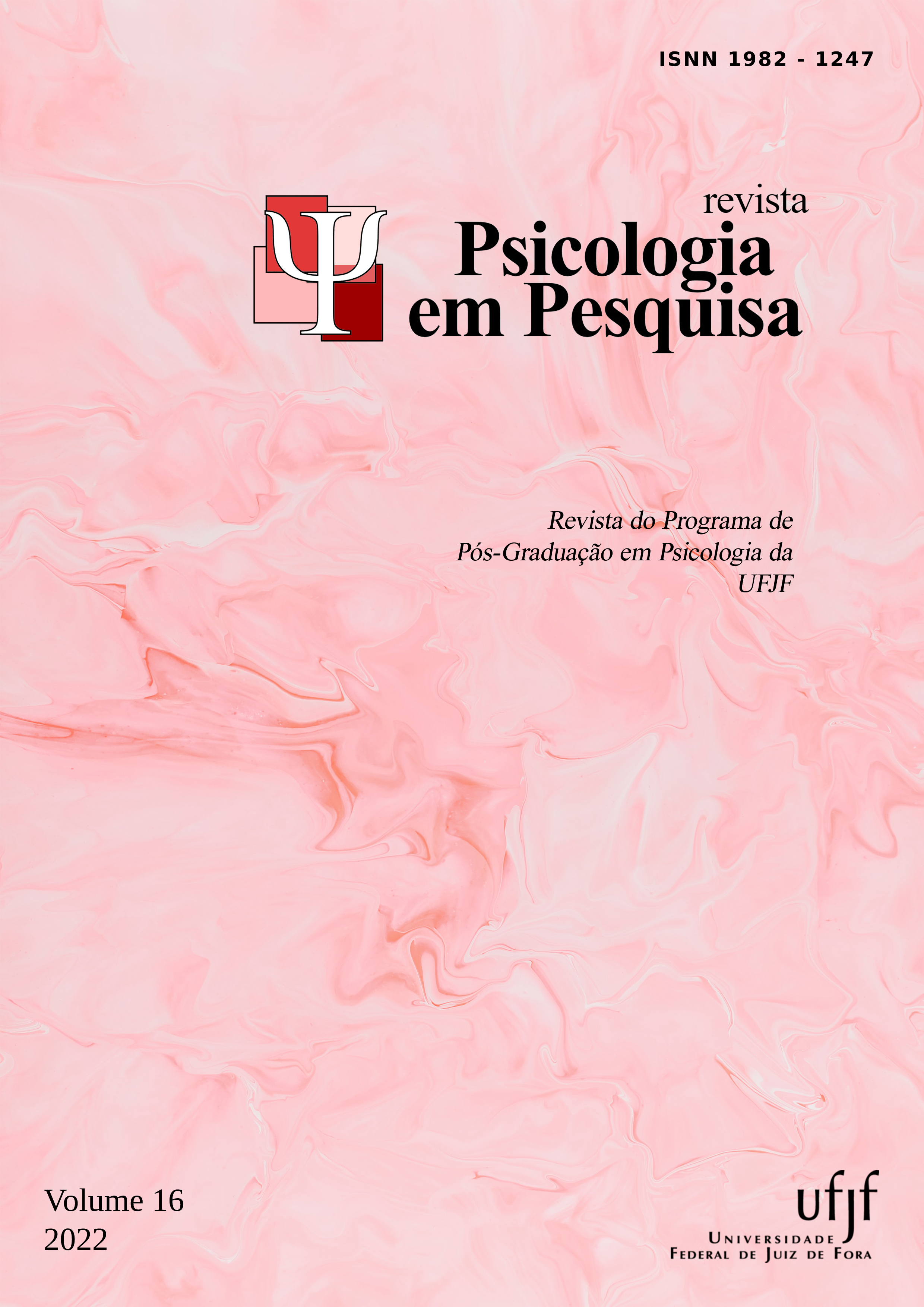Light Triad Scale: Psychometric properties of the Brazilian-Portuguese version and the relationship with positive aspects
DOI:
https://doi.org/10.34019/1982-1247.2022.v16.31427Keywords:
Psicologia Positiva, Testes psicológicos, Traços de personalidadeAbstract
This research aimed to adapt the Light Triad Scale to the Brazilian context. Two studies were carried out. The first tested for evidence based on internal structure, while the second evidence based on relations to other variables. The sample consisted of 454 participants, aged between 18 and 64 years, who responded to the Light Triad Scale, the Escala de Forças de Caráter, the Prosocial Personality Inventory, and the Inventário de Competências Emocionais. The Brazilian version of the instrument presented satisfactory evidence and proved to be useful for measuring positive personality traits.
Downloads
References
Allport, G. W. (1937). Personality: A Psychological Interpretation. London: Constable.
Asparouhov, T., & Muthén, B. (2009). Exploratory structural equation modeling. Structural Equation Modeling: A Multidisciplinary Journal, 16(3), 397-438. doi:10.1080/10705510903008204
Bueno, J. M. H., Correia, F. M. de L., Abacar, M., Gomes, Y. de A., & Pereira Júnior, F. S. (2015). Competências emocionais: estudo de validação de um instrumento de medida. Revista Avaliação Psicológica, 14(1), 153–163. doi:10.15689/ap.2015.1401.17
Costa Jr., P. T., McCrae, R. R., & Löckenhoff, C. E. (2018). Personality across the life span. Annual Review of Psychology, 70(1), 21.1-21.26. doi:10.1146/annurev-psych-010418-103244
Dann, T. J., Baguley, T., & Brunsden, V. (2014). From alpha to omega: A pratical solution to the pervasive problem of internal consistency estimation. British Journal of Psychology, 105(3), 399-412. doi:10.1111/bjop.12046
Diener, E., & Lucas, R. E. (2019). Personality Traits. In R. Biswas-Diener & E. Diener (Eds), Noba Textbook Series: Psychology. Champaign, IL: DEF Publishers. Recuperado de: https://nobaproject.com/modules/personalitytraits
Gerymski, R., & Krok, D. (2019). Psychometrics properties and validation of the Polish adaptation of the Light Triad Scale. Current Issue in Personality Psychology, 7(4), 341-354. doi:10.5114/cipp.2019.92960
Graziano, W. G., & Eisenberg, N. H. (1997). Agreeableness: A dimension of personality. In R. Hogan, J. Johnson, & S. Briggs (Eds.), Handbook of Personality Psychology (pp. 795-824). San Diego, CA: Academic Press.
Gouveia, V. V., Oliveira, I. C. V., Grangeiro, A. S. M., Monteiro, R. P, & Coelho, G. L. H. (2020). The bright side of the human personality: Evidence of a measure of prosocial traits. Journal of Happiness Studies, 1-22. doi:10.1007/s10902-020-00280-2
Hilbrand, S., Coall, D. A., Meyer, A. H., Gerstorf, D., & Hertwig, R. (2017). A prospective study of associations among helping, health, and longevity. Social Science & Medicine, 187, 109–117. doi:10.1016/j.socscimed.2017.06.035
Hu, L., & Bentler, P. M. (1999). Cutoff criteria for fit indexes in covariance structure analysis: Conventional criteria versus new alternatives. Structural Equation Modeling: A Multidisciplinary Journal, 6(1), 1-55. doi:10.1080/10705519909540118
International Test Commission. (2017). International Test Commission guidelines for translating and adapting tests (Second edition). Recuperado de https://www.intestcom.org/files/guideline_test_adaptation_2ed.pdf
Johnson, L. K. D. (2018). The Light Triad Scale: Developing and validating a preliminary measure of prosocial orientation (Master’s thesis). Available from Electronic Thesis and Dissertation Repository. 5515. https://ir.lib.uwo.ca/etd/5515
Kaufman, S. B., Yaden, D. B., Hyde, E., & Tsukayama, E. (2019). The light vs. dark triad of personality: Contrasting two very different profiles of human nature. Frontiers in Psychology, 10, 1-26. doi:10.3389/fpsyg.2019.00467
Lai, K., & Green, S. B. (2016). The problem with having two watches: Assessment of fit when RMSEA and CFI disagree. Multivariate Behavioral Research, 51(2-3), 220-239. doi:10.1080/00273171.2015.1134306
Moshagen, M., Hilbig, B. E., & Zettler, I. (2018). The dark core of personality. Psychological Review, 125(5), 656–688. doi:10.1037/rev0000111
Muthén, L. K., & Muthén, B. O. (1998-2012). Mplus User’s Guide. Seventh Edition. Los Angeles, CA: Muthén & Muthén.
Neumann, C. S., Kaufman, S. C., ten Brinke, L., Yaden, D. B., Hyde, E., & Tsykayama, E. (2020). Light and dark trait subtypes of human personality – A multi-study person-centered approach. Personality and Individual Differences, 164. doi:10.1016/j.paid.2020.110121
Niemiec, R. M. (2019). Finding the golden mean: The overuse, underuse, and optimal use of character strengths. Counselling Psychology Quarterly, 1–19. doi:10.1080/09515070.2019.1617674
Noronha, A. P. P., & Barbosa, A. J. C. (2016). Escala de Forças de Caráter. Amparo, SP: Universidade São Francisco.
Paulhus, D. L. (2014). Toward a taxonomy of dark personalities. Current Directions in Psychological Science, 23(6), 421–426. doi:10.1177/0963721414547737
Paulhus, D. L., & Williams, K. M. (2002). The dark triad of personality: Narcissism, machiavellianism, and psychopathy. Journal of research in personality, 36(6), 556-563. doi:10.1016/S0092-6566(02)00505-6
Reppold, C. T., Zanini, D. S., Campos, D. C., de Gomes Faria, M. R. V., & Tocchetto, B. S. (2019). Felicidade como produto: Um olhar crítico sobre a ciência da psicologia positiva. Avaliaçao Psicologica, 18(4), 333-342. doi:10.15689/ap.2019.1804.18777.01
Seligman, M. E. P. (2002). Positive Psychology, Positive Prevention and Positive Therapy. In C. Snyder & S. Lopez (Eds.). Handbook of Positive Psychology (pp. 3-9). New York: Oxford.
Seligman, M. E. P., & Csikszentmihalyi, M. (2014). Positive Psychology: An Introduction. In Flow and the Foundations of Positive Psychology (pp. 279-298). Dordrecht: Springer.
The Jamovi Project (2020). jamovi. (Versão 1.2) [Software]. Recuperado de https://www.jamovi.org.















